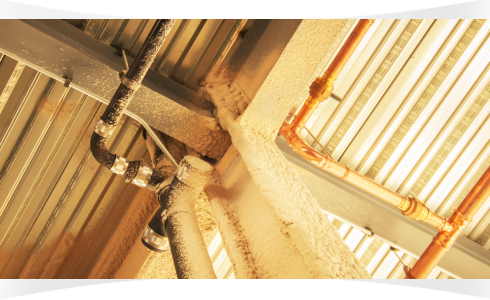



Fireproofing, a passive fire protection measure, refers to the act of making materials or structures more resistant to fire, or material for use in making anything fire-proof, or the act of applying such materials. Applying a certification listed fireproofing system to certain structures allows these to have a fire-resistance rating.
An item classed as fireproof is resistant in specified circumstances, and may burn or be rendered inoperable by fire exceeding the intensity or duration that it is designed to withstand.
| METHODS | MARKETS | APPLICATIONS |
| Commercial construction | Structural steel to keep below critical temperature ca. 540 °C | |
| Residential construction | Electrical circuits to keep critical electrical circuits below 140 °C so they stay operational | |
| Industrial construction | Liquified petroleum gas containers to prevent a BLEVE (boiling liquid expanding vapour explosion) | |
| Intumescent Fireproofing | Marine (ships) | Vessel skirts and pipe bridges in an oil refinery or chemical plant to keep the structural steel below critical temperature ca. 540° |
| Cementitious Fireproofing | Offshore construction | Concrete linings of traffic tunnels |
| Aerodynamics | ||
| Tunnel concrete walls and ceilings or linings | ||
| Under and above ground mining operations |
Intumescent coatings are used for protection of steelwork. Coatings which when exposed to flame or intense heat decompose and bubble into a foam which protects die substrate and prevents the flame from spreading.
Intumescent Fireproofing is used in any area where smooth, durable, and decorative multi-hour fire protection is required. It gives architects the ability to design using steel colors that can be aesthetically pleasing. The color options are limitless!
Intumescent fireproofing differs from cementitious and mineral fiber fireproofing in that its paint like appearance allows it to be left permanently exposed creating a dramatic architectural affect. Applied like paints and coatings with airless spray equipment, Intumescent fireproofing actually burns when exposed to fire, forming a layer of char that ultimately insulates the structural steel from further temperature rise
Cementitious or wet mix fireproofing is mixed with water and pumped under pressure through hoses to a nozzle where air is introduced. The wet slurry is then broadcast onto structural steel surfaces. The inherent fire resistive mechanism of products is the release of water, in the form of steam, when exposed to elevated temperatures
ABSTRACT’s team of specialty contractors and craftsmen have extensive experience applying a wide range of fireproofing materials and systems, including:
Concrete Encapsulation
Fixed Water Spray Systems
Intumescent Epoxy Coatings
Spray-applied Fire Resistive Materials (SFRM)
Subliming, Intumescent, and Ablative Mastics
Lightweight Castable Cementitious Products
Pre-formed Inorganic Panels or Masonry
Endothermic Wraps